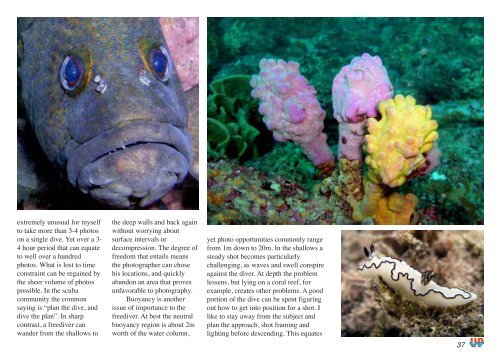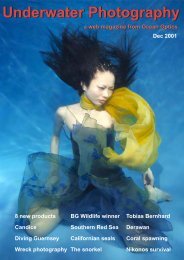Underwater Photography - SENSACIONES.org
Underwater Photography - SENSACIONES.org
Underwater Photography - SENSACIONES.org
You also want an ePaper? Increase the reach of your titles
YUMPU automatically turns print PDFs into web optimized ePapers that Google loves.
extremely unusual for myself<br />
to take more than 3-4 photos<br />
on a single dive. Yet over a 3-<br />
4 hour period that can equate<br />
to well over a hundred<br />
photos. What is lost to time<br />
constraint can be regained by<br />
the sheer volume of photos<br />
possible. In the scuba<br />
community the common<br />
saying is “plan the dive, and<br />
dive the plan”. In sharp<br />
contrast, a freediver can<br />
wander from the shallows to<br />
the deep walls and back again<br />
without worrying about<br />
surface intervals or<br />
decompression. The degree of<br />
freedom that entails means<br />
the photographer can chose<br />
his locations, and quickly<br />
abandon an area that proves<br />
unfavorable to photography.<br />
Buoyancy is another<br />
issue of importance to the<br />
freediver. At best the neutral<br />
buoyancy region is about 2m<br />
worth of the water column,<br />
yet photo opportunities commonly range<br />
from 1m down to 20m. In the shallows a<br />
steady shot becomes particularly<br />
challenging, as waves and swell conspire<br />
against the diver. At depth the problem<br />
lessens, but lying on a coral reef, for<br />
example, creates other problems. A good<br />
portion of the dive can be spent figuring<br />
out how to get into position for a shot. I<br />
like to stay away from the subject and<br />
plan the approach, shot framing and<br />
lighting before descending. This equates<br />
37
















